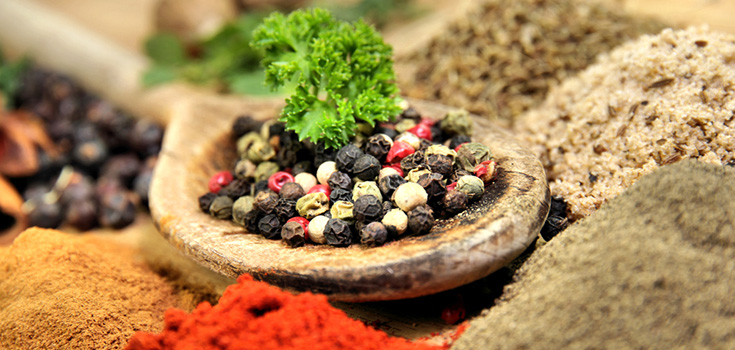Healthy Spices Worth Adding to Your Recipes

Joanna Dolgoff, M.D.
The Huffington Post
June 19, 2011
Not only do herbs and spices provide flavor for very few calories, but they also have some amazing, disease-fighting antioxidants in them! Be sure to fill up your spice rack, cabinet or drawer with the list provided below; this way, you’ll always be ready to spice up your recipes and rack up the health benefits!
Cinnamon
Health Benefit: Can potentially lower blood sugar, triglycerides, LDL and total cholesterol in people with Type 2 diabetes. Aim for a quarter to half a teaspoon of cinnamon twice a day.
Get Cooking: Dip berries or bananas in low-fat sour cream, then in a mix of 1 teaspoon ground cinnamon and 1/4 cup brown sugar.
Ginger
Health Benefit: Ginger can decrease motion sickness and nausea; may also relieve pain and swelling associated with arthritis. Doses used in clinical trials range from 500 to 2,000 mg of powdered ginger. (A quarter-sized piece of fresh root contains about 1,000 mg.) More than 6,000 mg can cause stomach irritation. Ginger can also hinder blood clotting, so if you’re about to have surgery or are taking blood thinners or aspirin, be sure to talk to your doctor first.
Get Cooking: Add 1/4 teaspoon ground ginger to vegetables like carrots and sweet potatoes, as well as fresh fruit (especially peaches).
Turmeric
Health Benefit: Contains curcumin, which some data shows may possibly inhibit the growth of cancer cells.
Get Cooking: For an Indian flavor, add 1/4 teaspoon
Paprika
Health Benefit: Contains capsaicin, which has anti-inflammatory and antioxidant effects that may lower the risk of cancer (also found in cayenne and red chili peppers). There’s no specific recommended dose, but moderation is probably the best way to go.
Get Cooking: Combine 1 1/2 teaspoons paprika, 1/2 teaspoon ground thyme and 1/2 teaspoon ground red pepper to liven up popcorn.
Garlic
Health Benefit: Studies suggest that one or two cloves weekly may possibly provide cancer-protective benefits.
Get Cooking: Saute fresh garlic over low heat and mix with pasta, red pepper flakes and Parmesan cheese.
Rosemary
Health Benefit: Can potentially stop gene mutations that could lead to cancer and may help prevent damage to the blood vessels that raise heart attack risk.
Get Cooking: For a delicious chicken rub, combine 2 teaspoons of rosemary leaves with 2 teaspoons seasoning salt and 1/2 teaspoon of thyme leaves.
Oregano
Health Benefit: A USDA study found that, gram for gram, oregano has the highest antioxidant activity of 27 fresh culinary herbs.
Get Cooking: To spice up tomato soup, add 3/4 teaspoon oregano to one can; add 1/2 teaspoon to 2 cups pasta or pizza sauce. Substitute 1 teaspoon dried oregano for 2 teaspoons fresh.
Basil
Health Benefit: Flavonoids in basil may protect your cells and chromosomes from radiation and other damage. Basil also has antibacterial and anti-inflammatory properties — plus it packs in heart-healthy beta-carotene and is an excellent source of vitamin K.
Get Cooking: Ground with garlic and olive oil into a paste, basil is a prime ingredient in pistou, a Mediterranian specialty. In Italy, pine nuts and sometimes grated hard cheese are added to the paste to become pesto. Pesto is most often served with pasta.
Cilantro
Health Benefits: May help to control blood sugar and cholesterol; it also contains phytonutrients, fiber, manganese, iron and magnesium. Some research indicates it may help to fight salmonella bacteria, as well.
Get Cooking: Add cilantro to homemade salsa, guacamole or salads. Use a bit of fresh cilantro mixed with the traditional lettuce and tomato salad for a nice twist.
Chilli Pepper
Health Benefits: Chili pepper can fight inflammation, provide natural pain relief and it’s currently being studied as a natural aid for arthritis patients. The heat can also clear congestion and studies suggest chili pepper could be effective in aiding weight loss.
Get Cooking: The next time you make healthy sautéed vegetables, add some chili peppers to turn up the spice volume.
